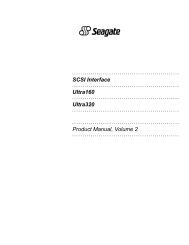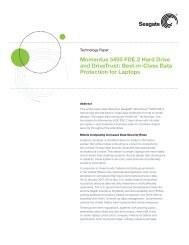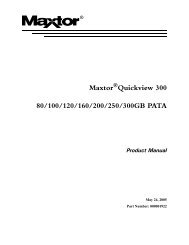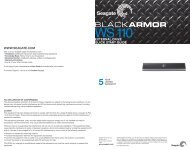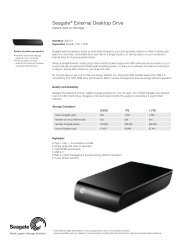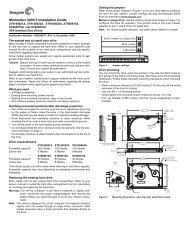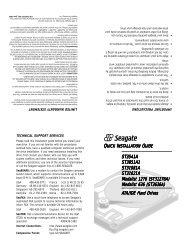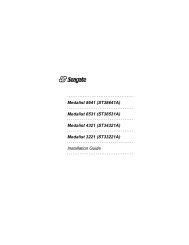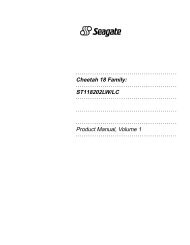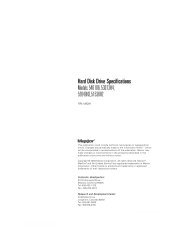Barracuda 18LP Family: ST39175LW/LC ST318275LW ... - Seagate
Barracuda 18LP Family: ST39175LW/LC ST318275LW ... - Seagate
Barracuda 18LP Family: ST39175LW/LC ST318275LW ... - Seagate
Create successful ePaper yourself
Turn your PDF publications into a flip-book with our unique Google optimized e-Paper software.
12 <strong>Barracuda</strong> <strong>18LP</strong> Product Manual, Rev. E<br />
4.5.1 Caching write data<br />
Write caching is a write operation by the drive that makes use of a drive buffer storage area where the data to<br />
be written to the medium is stored in one or more segments while the drive performs the write command.<br />
If read caching is enabled (RCD=0), then data written to the medium is retained in the cache to be made available<br />
for future read cache hits. The same buffer space and segmentation is used as set up for read functions.<br />
The buffer segmentation scheme is set up or changed independently, having nothing to do with the state of<br />
RCD. When a write command is issued, if RCD=0, the cache is first checked to see if any logical blocks that<br />
are to be written are already stored in the cache from a previous read or write command. If there are, the<br />
respective cache segments are cleared. The new data is cached for subsequent Read commands.<br />
If the number of write data logical blocks exceeds the size of the segment being written into, when the end of<br />
the segment is reached, the data is written into the beginning of the same cache segment, overwriting the data<br />
that was written there at the beginning of the operation. However, the drive does not overwrite data that has not<br />
yet been written to the medium.<br />
If write caching is enabled (WCE=1), then the drive may return GOOD status on a write command after the<br />
data has been transferred into the cache, but before the data has been written to the medium. If an error occurs<br />
while writing the data to the medium, and GOOD status has already been returned, a deferred error will be<br />
generated. Write commands that have returned GOOD status but still have uncommitted data in the cache are<br />
treated similarly to a normal queued command and therefore occupy a command queue slot. This may temporarily<br />
reduce the number of commands that may be queued by the host until the write data has been written to<br />
the medium.<br />
The Synchronize Cache command may be used to force the drive to write all cached write data to the medium.<br />
Upon completion of a Synchronize Cache command, all data received from previous write commands will have<br />
been written to the medium. The Start/Stop command with the stop bit set will force a sync cache operation<br />
before the drive stops.<br />
Tables 9a and 9b show Mode default settings for the drives.<br />
4.5.2 Prefetch operation<br />
If the Prefetch feature is enabled, data in contiguous logical blocks on the disc immediately beyond that which<br />
was requested by a Read command can be retrieved and stored in the buffer for immediate transfer from the<br />
buffer to the host on subsequent Read commands that request those logical blocks (this is true even if “cache”<br />
operation is disabled). Though the prefetch operation uses the buffer as a “cache”, finding the requested data<br />
in the buffer is a prefetch “hit”, not a “cache” operation “hit”. Prefetch is enabled using Mode Select page 08h,<br />
byte 12, bit 5 (Disable Read Ahead - DRA bit). DRA bit = 0 enables prefetch. Since data that is prefetched<br />
replaces data already in some buffer segment(s), the host can limit the amount of prefetch data to optimize<br />
system performance. The max prefetch field (bytes 8 and 9) limits the amount of prefetch. The drive does not<br />
use the prefetch “ceiling” field (bytes 10 and 11).<br />
During a prefetch operation, the drive crosses a cylinder boundary to fetch more data only if the Discontinuity<br />
(DISC) bit is set to one in bit 4 of byte 2 of Mode parameters page 08h.<br />
Whenever prefetch (read look-ahead) is enabled (enabled by DRA = 0), it operates under the control of ARLA<br />
(Adaptive Read Look-Ahead). If the host uses software interleave, ARLA enables prefetch of contiguous blocks<br />
from the disc when it senses that a prefetch “hit” will likely occur, even if two consecutive read operations were<br />
not for physically contiguous blocks of data (e.g. “software interleave”). ARLA disables prefetch when it decides<br />
that a prefetch “hit” will not likely occur. If the host is not using software interleave, and if two sequential read<br />
operations are not for contiguous blocks of data, ARLA disables prefetch, but as long as sequential read operations<br />
request contiguous blocks of data, ARLA keeps prefetch enabled.



